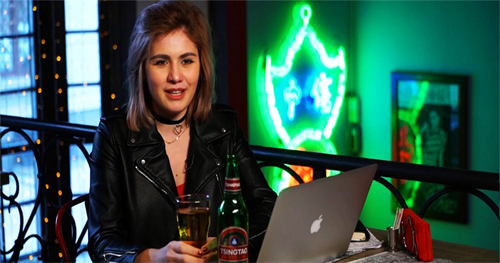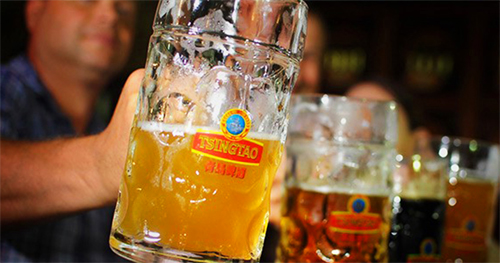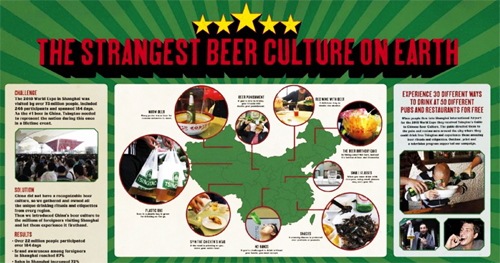Valeria Frolova hasn’t seen her father in years. She was 5 when he left on a voyage to the South Pole, as Valeria would later be told, by her devoted mother, Nadezhda. Growing up, Valeria longed to meet her Father, and cites his absence in her life as the inspiration behind her work as a video blogger. After years of pestering her mother for more information, years of wondering about her father and what life might have been had he not left, Valeria may be on course to finally meet him, and it’s all thanks to Tsingtao beer.

The story is a fascinating one. As told by Valeria to Bon-Cloud, it begins in a nice Chinese restaurant in central Moscow. One day while sat working away with a cold, refreshing glass of Tsingtao at her side, Valeria happened upon an intriguing advertisement on the company’s website. A girl had left a Tsingtao beer at the Polar Bar in Ushuaia, on the very southernmost tip of Argentina. Why? The beer was intended for any lucky traveller, on their way to the South Pole. Ushuaia is one of the most remote locations in the world, and the most common last-stop for travellers on the route to the South Pole. Not usually one to give undue credence to coincidence, Valeria couldn’t ignore the obvious — this was a sign.
Destiny, it seems, tastes like Tsingtao beer.
So Valeria made plans, with the help of Tsingtao, to embark on a grand adventure to the South Pole that will hopefully bring about a long-awaited reunion with her father, but at very least will be a once-in-a-lifetime adventure — plus free beer!
I’m fortunate enough to have grown up with both my parents around, but Valeria’s struggle with missing her father, and wanting to find him, isn’t a difficult one to understand. On the face of it, maybe travelling to the South Pole in search of her Dad seems like a big decision to take so quickly, possibly even a dangerous one — but could you really ignore fate when it’s so obviously willing you to do something, particularly if it’s something you’ve always wanted anyway? I doubt I could. Valeria’s story should serve as a lesson to all of us, who sometimes let the mundanity of life get in the way of adventure — when life gives you a sign, pay attention! Seeing Tsingtao support Valeria embark on an adventure to pursue family reunion, and to chase her dream, I’d be lying if I said I didn’t feel like pursuing my own.
This story, and several other fascinating ones like it, have come to light after Tsingtao and Bon-Cloud asked people from all over the world to share their best stories involving Tsingtao beer in some way. It’s part of the Chinese beer-giant’s grander ethos; one that finds value in culture and history and believes in the ability of storytelling to unite and bring people together. The worldwide nature of the campaign also signifies the brand’s longstanding internationalism, and its own European/Chinese heritage.

As a writer and a lover of stories — true or otherwise — seeing a brand place so much importance on the telling and sharing of stories across the globe is a really heartening thing. The world is an incredibly divided place, and one of the ways we can best address that is by talking, telling stories that show our similarities and share our culture.
China’s 2nd best selling beer, and the 4th in best-selling in the entire world, Tsingtao is a well-established and revered brand in the beer business. Their best-known beer is Tsingtao: a delightful pilsner with a hoppy taste, usually served in an ice-cold, 640ml bottle — larger than most beers — which accounted for most of the 1.2Bn gallons they sold in 2017 alone. This means they produced around 2% of all the beer in the world! And in case you were wondering, it’s pronounced, Ching Dow.
Tsingtao’s own story is an interesting one too. It begins in China, in August 1903, with a group of German and British entrepreneurs and brewers, who decided to start a brewery at the foot of the Laoshan Mountain. Those brewers brought from Europe their own techniques, materials and methods, but what made Tsingtao a uniquely Chinese beer, was the pure and fresh water which came down from the mountain. The first ever Tsingtao beer was poured in December 22nd 1904, with the first Tsingtao-hangover likely being felt the next day!
The brewery persisted through many hardships — not least two world wars — and continued brewing beer on a large scale. Owned at different periods by the Japanese and Germans, then a Chinese family business, the brewery was eventually taken under state control after the revolution and the founding of the People’s Republic of China in 1949. Tsingtao continued to grow as a state-run enterprise for years, and in the 70’s it entered the US market, quickly becoming the most popular Chinese beer there — a claim it can still make today. In the early 90’s after significant reform, Tsingtao Brewery was re-privatised and entered the Honk Kong stock market as a strong worldwide competitor in the beer market.
Today, Tsingtao is sold in over 62 countries, largely due to an ambitious and dynamic marketing strategy which was adopted shortly after re-privatisation in the 90s. The Bon-Cloud collaboration is just the latest example of Tsingtao’s commitment to the importance of culture and history.

As part of their involvement with the 2010 World Expo in Shanghai, Tsingtao attempted to give visitors a truly authentic and unique experience, by bringing together many separate beer-drinking traditions from all over China, and in doing so, attempting to create a more unified Chinese beer culture. At an undoubtedly enormous cost, Tsingtao created its own adventure for visitors to the EXPO, aimed at giving an authentic taste of Chinese beer culture.

The adventure began at Shanghai International Airport, with visitors being given a Tsingtao Guide to Chinese Beer Culture, which contained within it the location of 50 bars and restaurants where they could go to drink Tsingtao beer, completely free! Spread across these bars and restaurants were all the different regional drinking traditions, etiquettes and activities, allowing foreign guests and locals alike to experience for themselves. All across Shanghai, revellers drank Tsingtao in all different ways; mixed with wine, warm, served from plastic bags and more. They also played a number of drinking games, like Spin the Chicken’s Head, and ate traditional insect snacks — I’d guess some aspects were more popular than others! All in all, millions of people were introduced to Chinese beer culture in a totally new way.
Not content with this alone, Tsingtao also took over all 13 lines of the main station in Shanghai for the 184-day duration of the EXPO and even commissioned a special TV show, called Chinese Beer Culture: The Proper Toast.
So not only did Tsingtao manage to bring together all the different cultural traditions around drinking in China, for the first time — they also found an interesting way to showcase that, and share it with the rest of the world, through the universal appreciation of beer. If anything signifies Tsingtao’s brand, then surely, it’s that idea.


